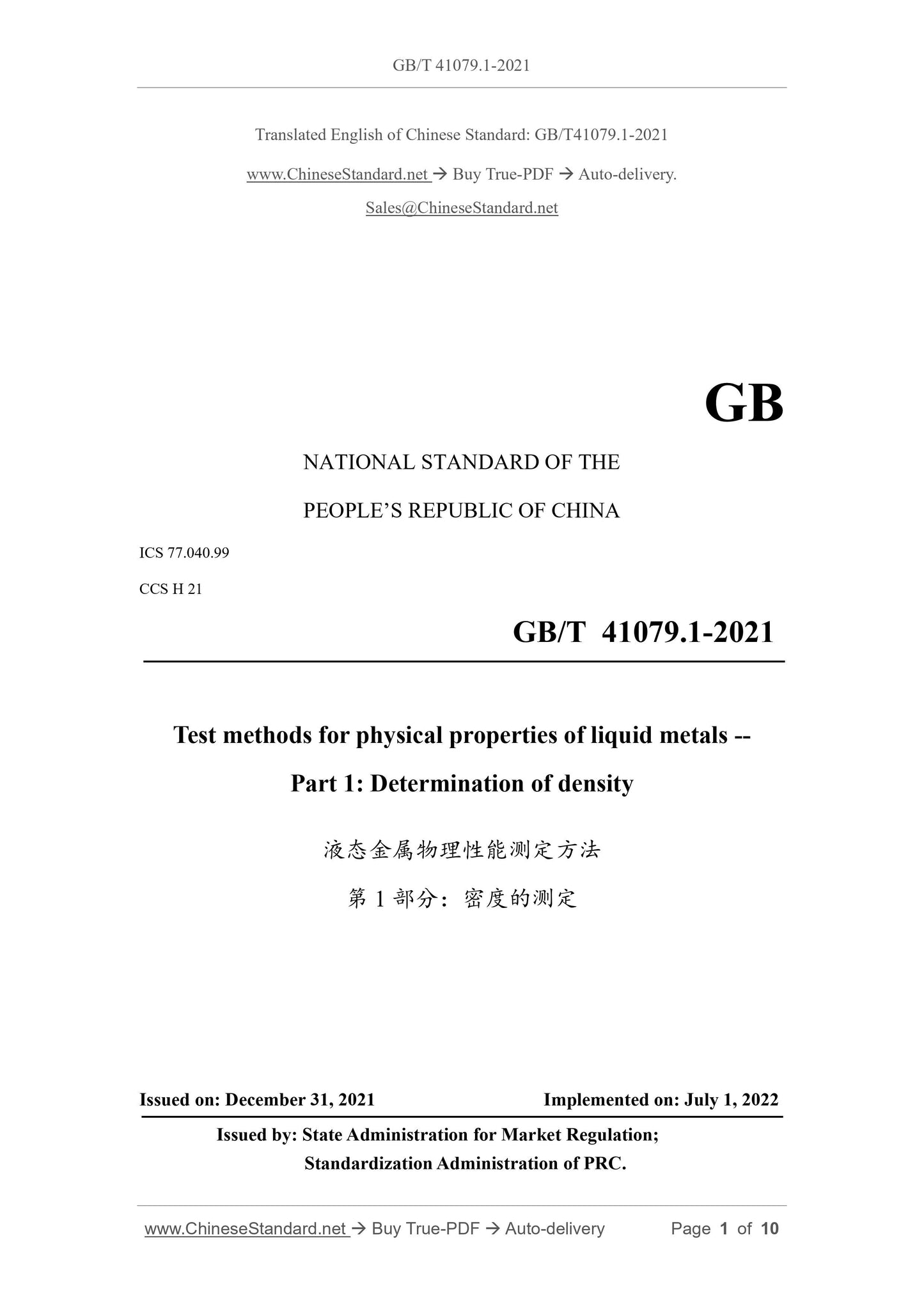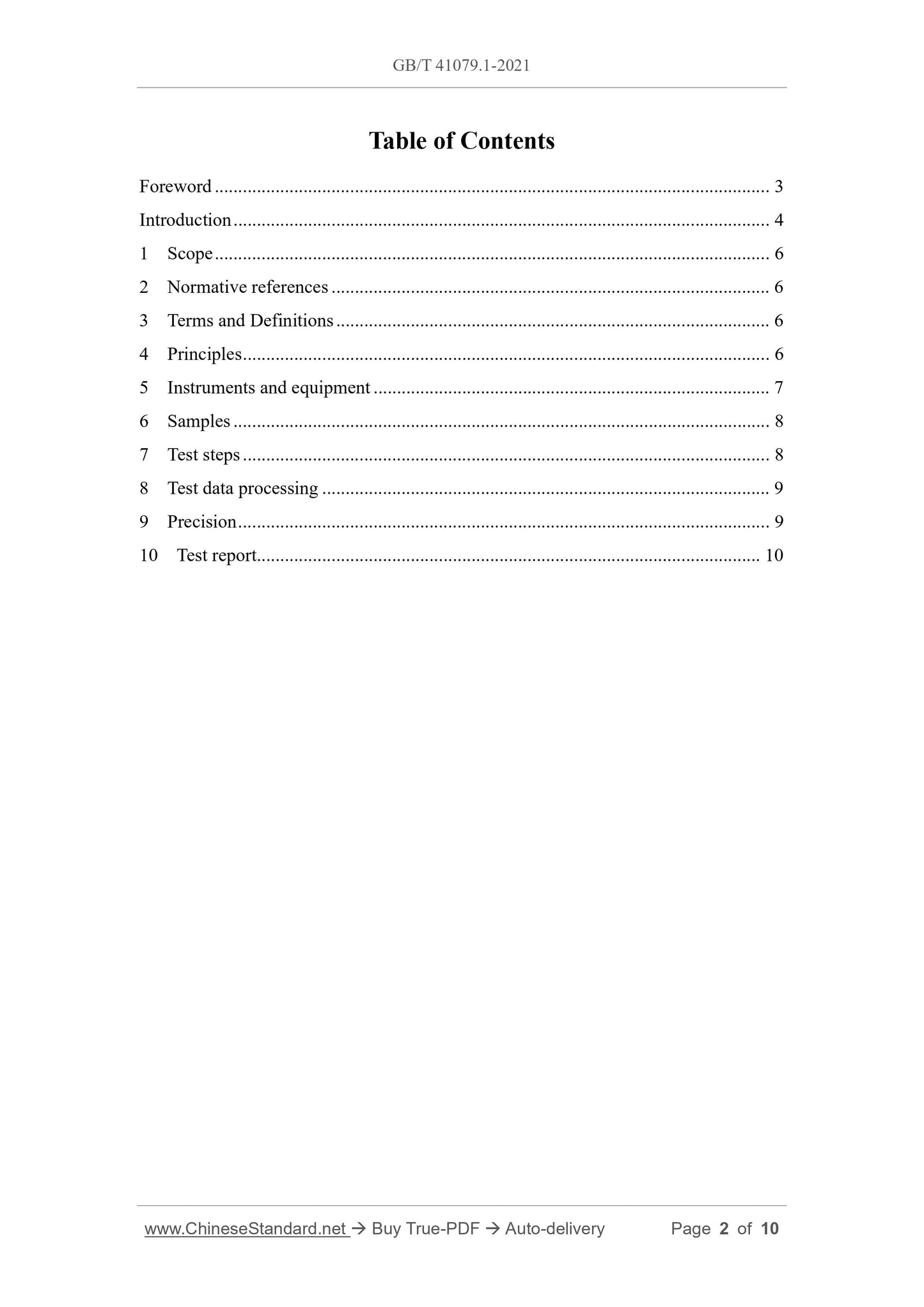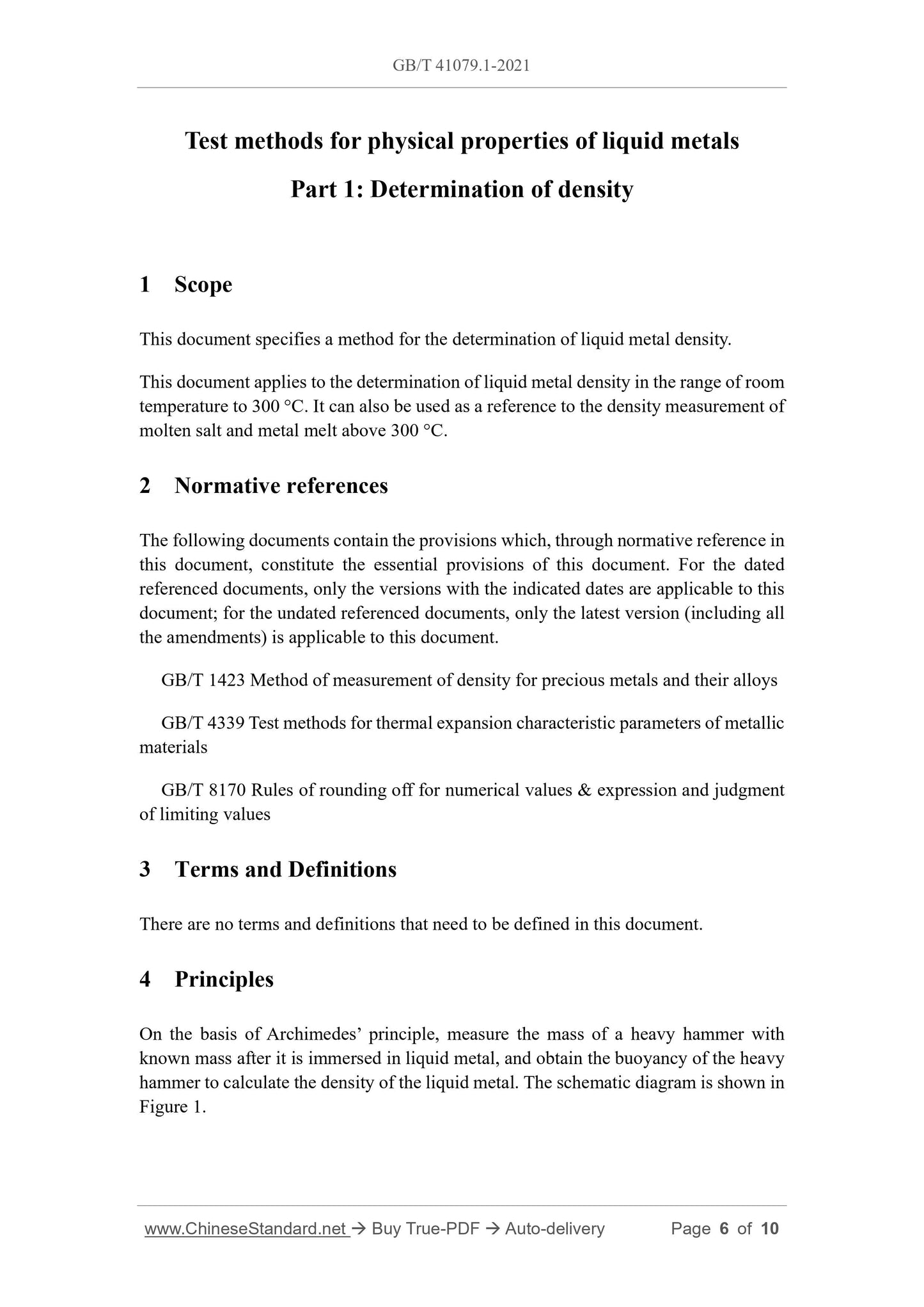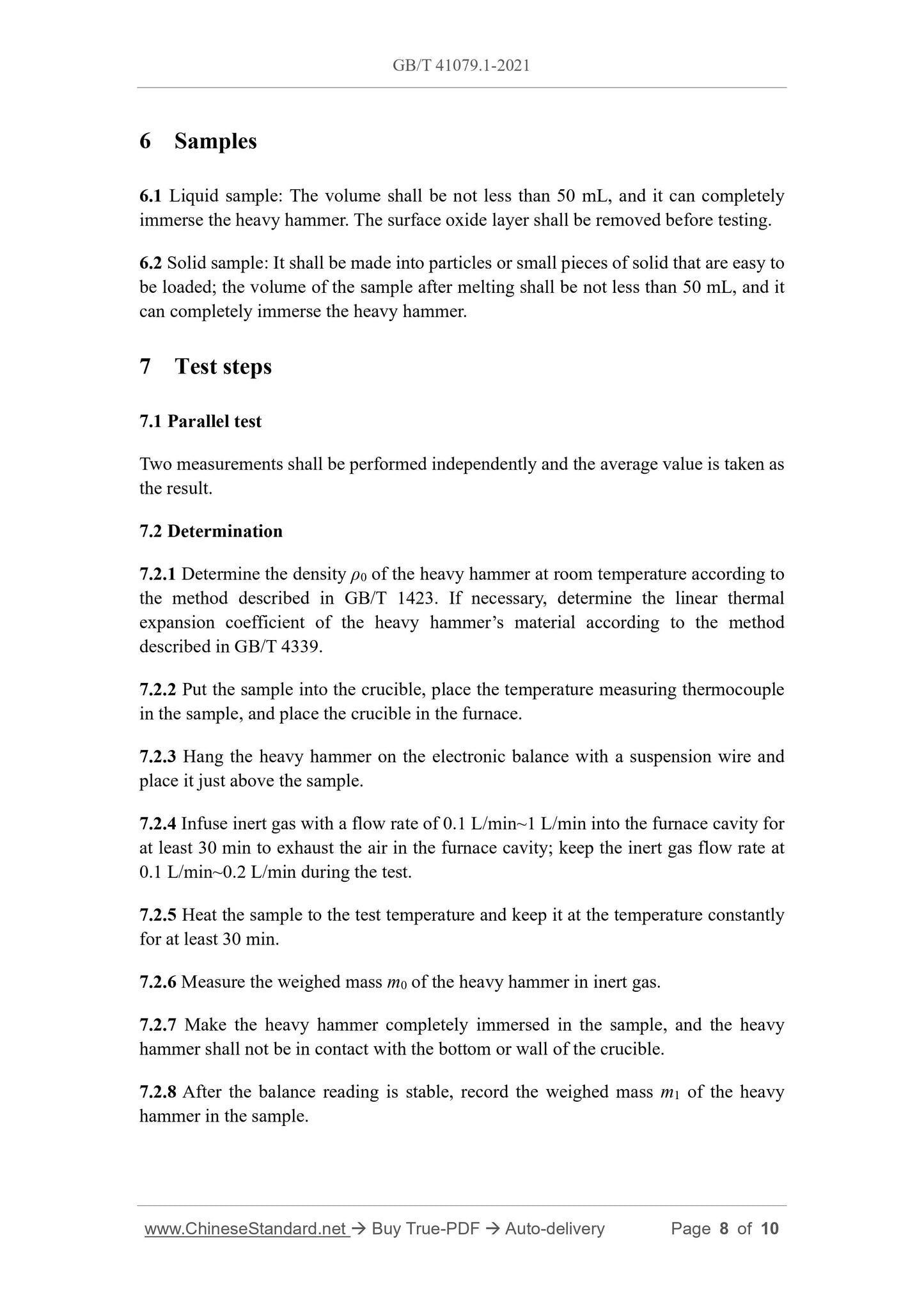1
/
of
4
PayPal, credit cards. Download editable-PDF & invoice in 1 second!
GB/T 41079.1-2021 English PDF (GBT41079.1-2021)
GB/T 41079.1-2021 English PDF (GBT41079.1-2021)
Regular price
$125.00 USD
Regular price
Sale price
$125.00 USD
Unit price
/
per
Shipping calculated at checkout.
Couldn't load pickup availability
Delivery: 3 seconds. Download true-PDF + Invoice.
Get QUOTATION in 1-minute: Click GB/T 41079.1-2021
Historical versions: GB/T 41079.1-2021
Preview True-PDF (Reload/Scroll if blank)
GB/T 41079.1-2021: Test methods for physical properties of liquid metals -- Part 1: Determination of density
GB/T 41079.1-2021
NATIONAL STANDARD OF THE
PEOPLE’S REPUBLIC OF CHINA
ICS 77.040.99
CCS H 21
Test methods for physical properties of liquid metals --
Part 1.Determination of density
ISSUED ON. DECEMBER 31, 2021
IMPLEMENTED ON. JULY 1, 2022
Issued by. State Administration for Market Regulation;
Standardization Administration of PRC.
Table of Contents
Foreword... 3
Introduction... 4
1 Scope... 6
2 Normative references... 6
3 Terms and Definitions... 6
4 Principles... 6
5 Instruments and equipment... 7
6 Samples... 8
7 Test steps... 8
8 Test data processing... 9
9 Precision... 9
10 Test report... 10
Test methods for physical properties of liquid metals
Part 1.Determination of density
1 Scope
This document specifies a method for the determination of liquid metal density.
This document applies to the determination of liquid metal density in the range of room
temperature to 300 °C. It can also be used as a reference to the density measurement of
molten salt and metal melt above 300 °C.
2 Normative references
The following documents contain the provisions which, through normative reference in
this document, constitute the essential provisions of this document. For the dated
referenced documents, only the versions with the indicated dates are applicable to this
document; for the undated referenced documents, only the latest version (including all
the amendments) is applicable to this document.
GB/T 1423 Method of measurement of density for precious metals and their alloys
GB/T 4339 Test methods for thermal expansion characteristic parameters of metallic
materials
GB/T 8170 Rules of rounding off for numerical values and expression and judgment
of limiting values
3 Terms and Definitions
There are no terms and definitions that need to be defined in this document.
4 Principles
On the basis of Archimedes’ principle, measure the mass of a heavy hammer with
known mass after it is immersed in liquid metal, and obtain the buoyancy of the heavy
hammer to calculate the density of the liquid metal. The schematic diagram is shown in
Figure 1.
6 Samples
6.1 Liquid sample. The volume shall be not less than 50 mL, and it can completely
immerse the heavy hammer. The surface oxide layer shall be removed before testing.
6.2 Solid sample. It shall be made into particles or small pieces of solid that are easy to
be loaded; the volume of the sample after melting shall be not less than 50 mL, and it
can completely immerse the heavy hammer.
7 Test steps
7.1 Parallel test
Two measurements shall be performed independently and the average value is taken as
the result.
7.2 Determination
7.2.1 Determine the density ρ0 of the heavy hammer at room temperature according to
the method described in GB/T 1423.If necessary, determine the linear thermal
expansion coefficient of the heavy hammer’s material according to the method
described in GB/T 4339.
7.2.2 Put the sample into the crucible, place the temperature measuring thermocouple
in the sample, and place the crucible in the furnace.
7.2.3 Hang the heavy hammer on the electronic balance with a suspension wire and
place it just above the sample.
7.2.4 Infuse inert gas with a flow rate of 0.1 L/min~1 L/min into the furnace cavity for
at least 30 min to exhaust the air in the furnace cavity; keep the inert gas flow rate at
0.1 L/min~0.2 L/min during the test.
7.2.5 Heat the sample to the test temperature and keep it at the temperature constantly
for at least 30 min.
7.2.6 Measure the weighed mass m0 of the heavy hammer in inert gas.
7.2.7 Make the heavy hammer completely immersed in the sample, and the heavy
hammer shall not be in contact with the bottom or wall of the crucible.
7.2.8 After the balance reading is stable, record the weighed mass m1 of the heavy
hammer in the sample.
Get QUOTATION in 1-minute: Click GB/T 41079.1-2021
Historical versions: GB/T 41079.1-2021
Preview True-PDF (Reload/Scroll if blank)
GB/T 41079.1-2021: Test methods for physical properties of liquid metals -- Part 1: Determination of density
GB/T 41079.1-2021
NATIONAL STANDARD OF THE
PEOPLE’S REPUBLIC OF CHINA
ICS 77.040.99
CCS H 21
Test methods for physical properties of liquid metals --
Part 1.Determination of density
ISSUED ON. DECEMBER 31, 2021
IMPLEMENTED ON. JULY 1, 2022
Issued by. State Administration for Market Regulation;
Standardization Administration of PRC.
Table of Contents
Foreword... 3
Introduction... 4
1 Scope... 6
2 Normative references... 6
3 Terms and Definitions... 6
4 Principles... 6
5 Instruments and equipment... 7
6 Samples... 8
7 Test steps... 8
8 Test data processing... 9
9 Precision... 9
10 Test report... 10
Test methods for physical properties of liquid metals
Part 1.Determination of density
1 Scope
This document specifies a method for the determination of liquid metal density.
This document applies to the determination of liquid metal density in the range of room
temperature to 300 °C. It can also be used as a reference to the density measurement of
molten salt and metal melt above 300 °C.
2 Normative references
The following documents contain the provisions which, through normative reference in
this document, constitute the essential provisions of this document. For the dated
referenced documents, only the versions with the indicated dates are applicable to this
document; for the undated referenced documents, only the latest version (including all
the amendments) is applicable to this document.
GB/T 1423 Method of measurement of density for precious metals and their alloys
GB/T 4339 Test methods for thermal expansion characteristic parameters of metallic
materials
GB/T 8170 Rules of rounding off for numerical values and expression and judgment
of limiting values
3 Terms and Definitions
There are no terms and definitions that need to be defined in this document.
4 Principles
On the basis of Archimedes’ principle, measure the mass of a heavy hammer with
known mass after it is immersed in liquid metal, and obtain the buoyancy of the heavy
hammer to calculate the density of the liquid metal. The schematic diagram is shown in
Figure 1.
6 Samples
6.1 Liquid sample. The volume shall be not less than 50 mL, and it can completely
immerse the heavy hammer. The surface oxide layer shall be removed before testing.
6.2 Solid sample. It shall be made into particles or small pieces of solid that are easy to
be loaded; the volume of the sample after melting shall be not less than 50 mL, and it
can completely immerse the heavy hammer.
7 Test steps
7.1 Parallel test
Two measurements shall be performed independently and the average value is taken as
the result.
7.2 Determination
7.2.1 Determine the density ρ0 of the heavy hammer at room temperature according to
the method described in GB/T 1423.If necessary, determine the linear thermal
expansion coefficient of the heavy hammer’s material according to the method
described in GB/T 4339.
7.2.2 Put the sample into the crucible, place the temperature measuring thermocouple
in the sample, and place the crucible in the furnace.
7.2.3 Hang the heavy hammer on the electronic balance with a suspension wire and
place it just above the sample.
7.2.4 Infuse inert gas with a flow rate of 0.1 L/min~1 L/min into the furnace cavity for
at least 30 min to exhaust the air in the furnace cavity; keep the inert gas flow rate at
0.1 L/min~0.2 L/min during the test.
7.2.5 Heat the sample to the test temperature and keep it at the temperature constantly
for at least 30 min.
7.2.6 Measure the weighed mass m0 of the heavy hammer in inert gas.
7.2.7 Make the heavy hammer completely immersed in the sample, and the heavy
hammer shall not be in contact with the bottom or wall of the crucible.
7.2.8 After the balance reading is stable, record the weighed mass m1 of the heavy
hammer in the sample.
Share








